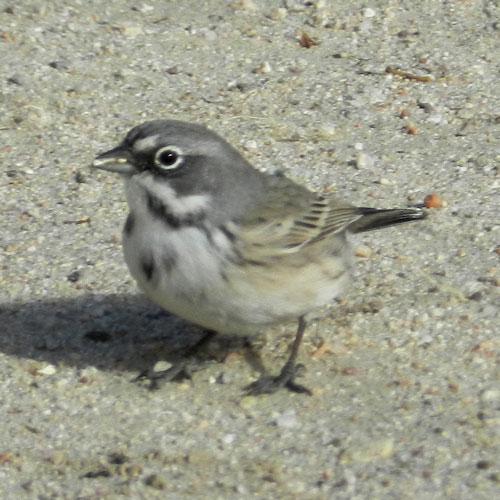To Breed or not to Breed
Sage Sparrow
The San Clemente sage sparrow (Amphispiza belli clementeae) is a threatened, non-migratory subspecies endemic to San Clemente Island (SCI), which is the southernmost of the California Channel Islands.
The U.S. Navy, which owns and manages SCI, has contracted the Institute for Wildlife Studies (IWS) to monitor this species since 1999.
The first time I flew out to SCI from mainland San Diego to work with the threatened San Clemente sage sparrow it was the middle of their breeding season and we had no idea what to expect. We knew that SCI was off-limits to civilians except those working with the military, so we felt fortunate to be one of the few biologists allowed to live and work on an island inhabited by a host of endemic animals and plants.
We had seen a topographic map of the island prior to our visit, but after a short 30-minute flight in a twin-engine propeller plane, the outline of the island began to take shape through the low fog, and we were stunned by its rugged terrain.
A large central plateau dominated by grasslands runs the spine of the island and is drained by long, rugged canyons that run southwest with shorter canyons on the eastern escarpment that are so steep that they seem to fall directly into the surrounding ocean (Figure 2). As the plane circled the landing strip on the northwest side of the island, we caught our first glimpse of the distinct marine terraces where San Clemente sage sparrows are predominantly found during the breeding season.
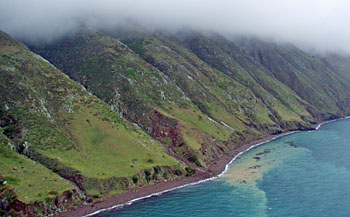
After landing, we maneuvered our truck around sinkholes in the road and gaping potholes, as we began to descend down a winding road to the lower marine terraces (Figure 3). During their breeding months, their distribution is associated with the vegetative zone covered by the maritime desert scrub—Lycium californicum (boxthorn) plant community located along the lower 2 to 3 western and southern marine terraces near the shoreline.
At lower elevations, boxthorn interspersed with cacti and forbs dominate the habitat, while at higher elevations coastal cholla cactus, prickly pear, and grasses predominate. Breeding season densities of sage sparrows vary across habitat. Densities are highest at lower elevations and decrease with increasing elevation along a moisture gradient.
During late summer and early fall juveniles flock at higher elevations. The winter distribution and habitat use by sage sparrows on SCI is only now being discovered through Navy-sponsored research in cooperation with the Institute for Wildlife Studies using radio-telemetry to track juveniles through their first winter.

No sooner had we seen our first patch of boxthorns, the primary substrate used for nesting by San Clemente sage sparrows, that we saw a sight that was soon to become very familiar. Perched precariously on a prickly pear cactus was a sparrow about 13-15 centimeters long with a dark grayish-brown back with indistinct dusky streaking and light, buffy underparts.
It had a small, isolated dark breast spot; a complete white eye ring; white supraloral spots on either side of the bill; and a prominent, broad black and white malar stripe.
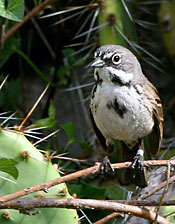
Its dark mantle and distinct malar stripe made mainland sage sparrows seem drab by comparison.
There are 5 recognized subspecies of the sage sparrow in North America:
- A. b. belli from coastal California and northwestern Baja California;
- A. b. clementeae on SCI;
- A. b. cinerea from west-central Baja California;
- A. b. canescens of the central interior of California, and;
- A. b. nevadensis found in the Great Basin.
The San Clemente sage sparrow differs from A. b. belli by the bill length, mantle coloration and streaking.
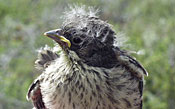
The juveniles are paler and more heavily streaked, but the sexes look similar.
Recently, the tenability of the San Clemente sage sparrow's classification as a distinct subspecies was disputed based on mean differences in morphological characters rather than a quantitative and statistically justified diagnosis of the population incorporating information on population distribution, dispersal, migratory tendency, habitat selection or potential genetic differences between A. b. belli and A. b. clementeae.
When we all piled out of the vehicle to take a closer look at the perched San Clemente sage sparrow, the high, warm winds struck us. The island experiences a Mediterranean dry summer subtropical climate with mild summer and winter temperatures, but almost constant wind.
Thick fog often covers San Clemente Island along the coastline and receives an average of 13 centimeter of rainfall annually, mostly between December and April. In our first year, the island received above-average rainfall and the boxthorn habitat was thriving with seemingly unlimited food resources and a blanket of wildflowers and other concealing vegetation across the landscape.
Sage sparrows are ground-gleaners and prey primarily on adult and larval insects and spiders but also feed on boxthorn berries, grass, thistle seeds, and succulent vegetation during the summer months. During the winter, sage sparrows eat primarily the fruit of prickly pear and cholla cactus and moths.
Unfortunately for the birds, the lush green island we first visited would transform into a dry, brown island during a prolonged drought over the next two years. Back then, we had no idea just how variable rainfall on the island would be from one year to the next and how strong the link was between winter rainfall and productivity of the San Clemente sage sparrows.
Habitat Variation in Wet and Dry Years
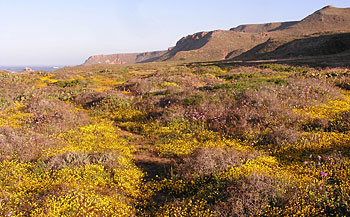

The Institute for Wildlife Studies has monitored the San Clemente sage sparrow since 1999, collecting data on the island-wide abundance and distribution of the population, habitat preferences, and the annual reproductive success and survival of juveniles and adults.
The majority of the data has been collected in 7 study plots and 15 transects along an elevation gradient. The data collected has contributed substantially to our understanding of the current threats to the population and the mechanisms regulating interannual variability in their reproduction and survival.
Adults are socially monogamous, begin reproducing in their first year and are multi-brooded, capable of attempting 5 broods in a single breeding season. Their timing of breeding is relatively flexible. Males typically establish breeding territories in February and begin singing short musical buzzes (click here to listen to sound byte) and courting females.
Males are highly aggressive during this period and commonly tussle mid-flight with neighboring males. They begin these interactions by countersinging along territory boundaries.
Each male assumes an aggressive posture with wings pressed flat against their sides, bill lowered, and flailed tail jerked up vertically toward the sky. Two territorial males approach each other in a series of short flights between perches and begin head bobbing while giving a hoarse quid quid call.
After a few seconds, the males will drop to the ground and run parallel to each other only half a meter apart. This behavior may continue for a few minutes interrupted by brief fights wherein the males fly 2 to 4 meters into the air, keeping in continuous contact with their feet. They will repeat this behavior until the victorious male claims his territory or extends the boundaries of his territory.
It is obvious when a female has chosen her mate because she raises her wings unilaterally with a slight quiver while bobbing her head as she forages and scopes out nest sites. The male follows close behind her taking cues that she is ready to move on with each wing raise and short tink note.
Once she has chosen her nest site, she will initiate nest building and copulate repeatedly with the male. The earliest breeding activity was recorded in the last week of December in 2007. The peak breeding activity occurs during March and April and extends through late June and early July.
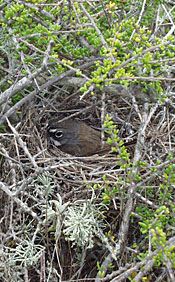
Females build open cup nests made with grass, lichen, twigs, and forb stems and lined with grasses, feathers, flower heads, and island fox (Urocyon littoralis) hair.
The number of pairs able to renest in a season depends on winter rainfall. Most birds complete 1 to 2 nest attempts in breeding seasons following winters with below average (40 - 80 millimeters) rainfall. Nest attempts increase with increasing rainfall, with most pairs completing 2 to 3 nest attempts when winter rainfall is average and 3 to 4 nest attempts when winter rainfall is above average (80 - 120 millimeters). In years with more than 120 millimeter of winter rainfall, some pairs can attempt up to 5 nests.
Clutch size ranges between 1 to 5 eggs, averaging 3 to 4 eggs over the breeding season. Eggs are bluish-white with dark brown and black markings in a wreath at the blunt end.
Clutch size varies among nest attempts in a counter-intuitive pattern. First nest attempts have significantly smaller clutches than second and third attempts, which contrasts with many other North American resident and migratory bird species.
The San Clemente sage sparrow population is highly sensitive to drought. The population typically grows, potentially quite rapidly, in non-drought years, but suffers dramatic declines following drought.
Drought primarily affects sage sparrows by substantially reducing breeding attempts and success. During severe droughts, the majority of pairs choose to forego breeding, and many adults do not establish territories and begin their post-nuptial molt early, which is unusual for migratory songbirds but common among semi-arid resident species.
San Clemente sage sparrow fecundity is enhanced by relatively low loss of eggs and nestlings to predation or other causes. From 2000 to 2007, less than 16% of nests failed during incubation and less than 33% of nests failed during nestling stages. Altogether, nest survival averaged 62.7%, with most nest failures attributable to predation and the entire clutch fledged from most (56%) successful nests.
In contrast, mainland subspecies suffer high predation rates because of a greater suite of nest predators compared to SCI including the gopher snake (Pituophis melanoleucus).
Low rainfall may reduce San Clemente sage sparrow fecundity indirectly by increasing nest predation. Reduced resource quality necessitates more frequent feeding visits or greater time spent foraging. Such increased parental activity or decreased parental vigilance may result in greater nest predation risk and lower nest success. Reduced resource quality may also lead to young birds fledging the nest in poor condition, leaving them more susceptible to predators as fledglings.
Fecundity is an especially important part of San Clemente sage sparrow ecology because it is highly variable and strongly correlated to population fluctuations. The relatively high potential fecundity of sage sparrows in some years promotes rapid population recovery following population crashes. However, there is no evidence that drought leads to reduced adult or juvenile survival.
Mean annual adult survival averaged 44% from 1999-2007, corresponding to an expected adult lifespan of 2-3 years. Adult survival fluctuates annually with no clear temporal trend.
In the last five years (2002-2007) adult survival has been stable, ranging between 34% and 52%. In contrast, annual juvenile survival has remained under 15% since falling dramatically from a peak of 71% in 2000 to 2001, to a low of 3% in 2004 to 2005.
The mean annual juvenile survival estimate from 1999 to 2007 was 28%. Given the extremely low juvenile survival observed in recent years, it is imperative to understand what mortality factors act on this stage of the sage sparrow life cycle, which is a current area of focus in ongoing IWS and Navy research.
Monitoring results suggest an increasing San Clemente sage sparrow population since the 1980s. The average population size between 1999 and 2007 was 771 adults with population spikes of 1,519 adults in 2002 and 1,216 adults in 2006.
Scientists attributed the original decline of San Clemente sage sparrows to reduced vegetative cover because of overgrazing and browsing by goats, sheep, pigs, deer, and cattle and the introduction of exotic predators including rats and cats.
Feral grazing and browsing mammals persisted on SCI from the mid-1800s to 1993 when all exotic browsers were completely eradicated by the U.S. Navy. Since their removal, areas of SCI that were previously mapped as grassland prior to goat eradication are now comprised of as much as 35% boxthorn and shrub and grass cover will continue to become denser each year without any grazing or browsing pressure.
Historically, introduced predators such as cats and rats have posed particularly strong threats to island birds such as the sage sparrow whose nesting habitats evolved in the absence of non-native mammalian predators. However, predation rates are substantially lower for the San Clemente sage sparrow compared to its mainland counterparts.
In addition, San Clemente sage sparrows are likely more vulnerable to residential or migrating raptors, San Clemente loggerhead shrikes (Lanius ludovicianus mearnsi), and island foxes. Disease and parasites pose another potential threat. Eight sage sparrows were observed with symptoms of avian pox during the 2007 breeding season.
Potentially, the greatest threat to the San Clemente sage sparrow is increased variability in rainfall patterns with advancing anthropogenic climate change because of their low rates of fecundity in dry years.
Funding for the research presented in this article was provided by the U.S. Navy as part of on-going Navy management of the San Clemente sage sparrow.

